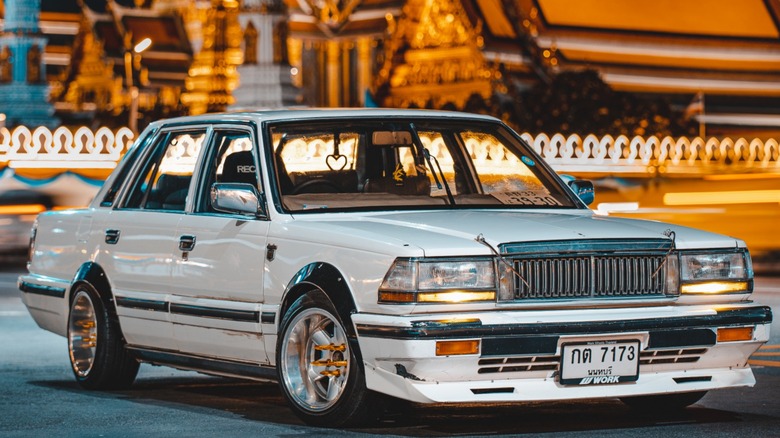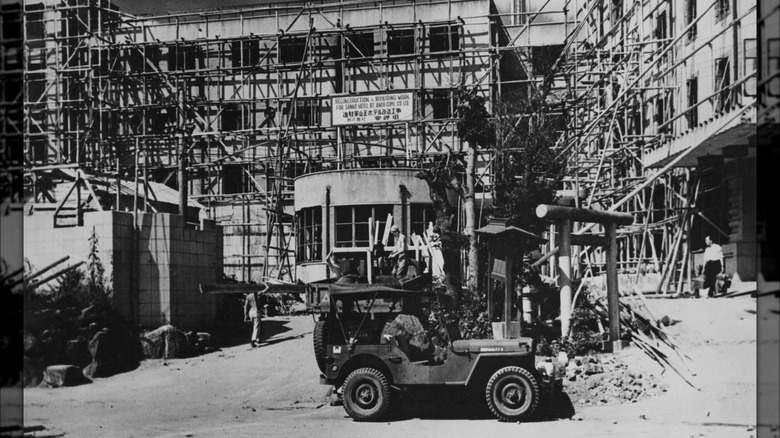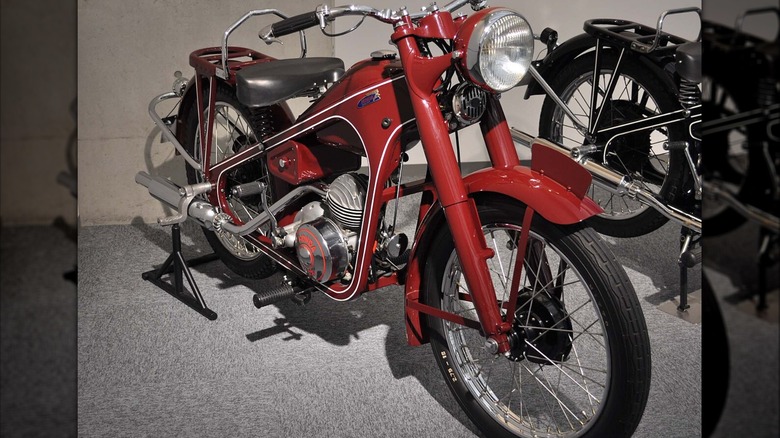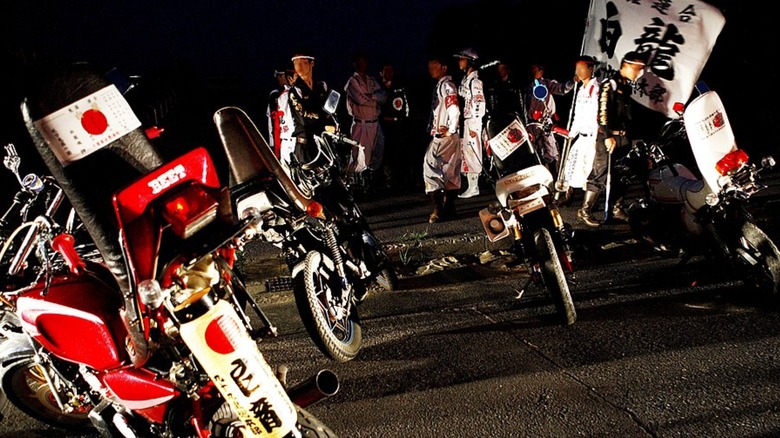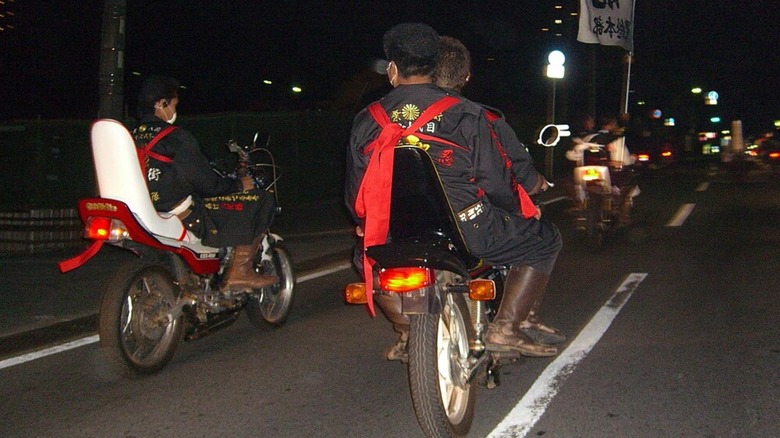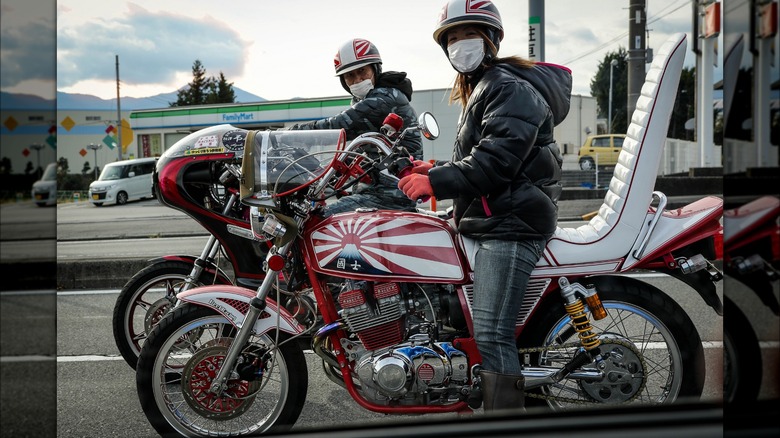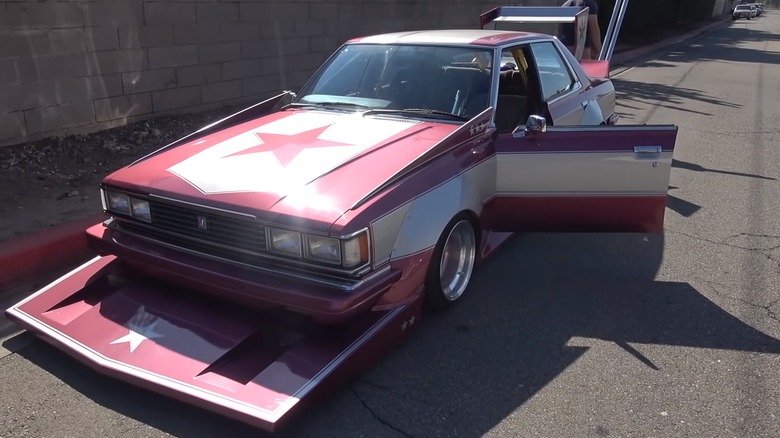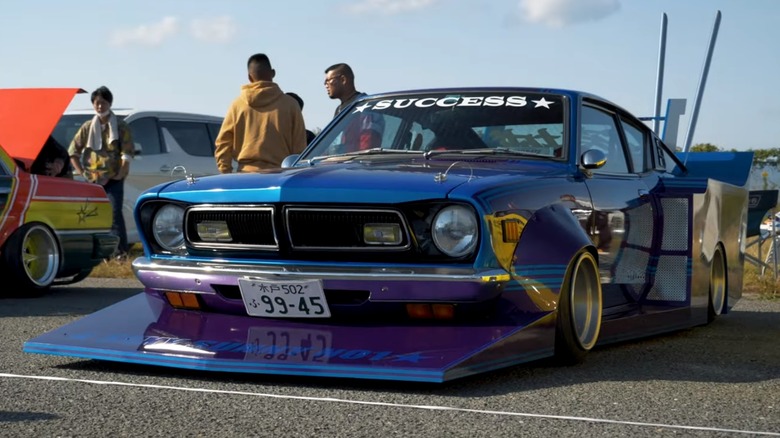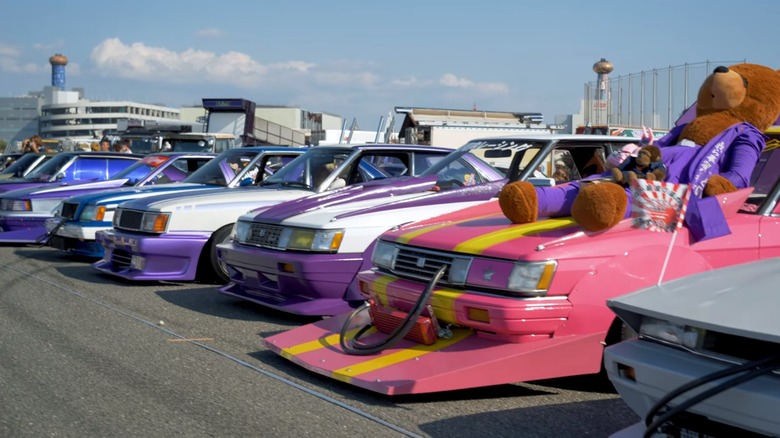Inside The Bizarre World Of Bosozoku Cars
Particular niches of car culture exist in most places around the globe. The drivers of Havana have their Yank Tanks, while Lowriders sprang up from Latino culture in Southern California. Raggare in Sweden is influenced by the greasers of the '50s in big American cars, while pickup truck culture is prominent in Texas. There's also the highly stylized and often outlandish customization of the Donks, which idolizes giant American sedans – such as the Chevy Impala – covered in custom high-gloss paint riding on wheels up to 30 inches in diameter.
However, there is perhaps no car culture with customization so extreme as Bosozoku in Japan. You may not know what Bosozoku is, but if you see one on the street, you are sure to take notice, as the cars are decorated and modified in ways that scream for attention and often defy logic.
After all, Japan has a rich culture surrounding cars that stems from its deeply rooted history of automobile manufacturing and produces cars renowned for excellent quality and legendary reliability. However, many Japanese models over the years tended to be a bit conservatively styled and could even be classified as dull. That inspired many young Japanese drivers to transform these beige boxes into multi-colored palettes that defy good taste and common sense. These are the Bosozoku, and this is their story.
From the world of post-war Japan
The work of rebuilding a devastated country began in earnest immediately upon the installation of the provisional American military government following Japan's World War II surrender. Reconstruction progressed at a fever pitch, quickly erasing the physical scars of conflict. As industry regained momentum and housing was replaced, life returned to normal, with the country set on a new and prosperous path guided by democracy and traditional Japanese culture.
It was in these times that former Kamikaze pilots – those who had either never been deployed or whose only missions failed to find a target — found themselves restless and having difficulty reintegrating into society. These young men would eventually band together with a shared understanding and a thirst for adventure and action, although they also often continued to harbor nationalistic fervor instilled in them by Imperial Japan.
For some, this made it difficult to assimilate into the newly minted democratic Japanese society. However, many were also affected by the widespread American culture that was permeating post-war Japan, particularly the influence of films that prominently featured motorcycles, such as "Rebel Without a Cause" and "The Wild One." These influences helped lay the foundations of Japan's notorious Bosozoku gangs.
The rise of Japanese motorcycles
With the country's infrastructure destroyed and the economy in shambles, industry had to restart operations, leading many companies to branch out into new areas based on the changing needs of the country. Foremost among needs was affordable transportation. With scarce materials and infrastructure in flux, motorcycle manufacturing represented the best opportunity for many companies, leading to the establishment of scores of manufacturers in the early '50s.
Respected Japanese motorcycle brands such as Kawasaki, Yamaha, and Honda can all trace their modern company back to this period. Furthermore, scores of other brands, such as Meguro, Yamaguchi, Miyata, and others began manufacturing, but most of them folded within a decade. The successful brands got a foothold in the market initially by producing small, cheap, and reliable motorized bicycles, scooters, and motorcycles, often using excess war materials and salvage parts to get started.
With successful models taking off, small bikes turned into bigger bikes while demand skyrocketed. By 1960, Japanese motorcycles were everywhere.
[Featured image by Rikita via Wikimedia Commons | Cropped and scaled | CC BY-SA 3.0]
Emergence of biker gangs
The former pilots started banding together in groups that were drawn to these new cheap motorcycles and started to ride together in various parts of the country. They gained the nickname Kaminari-zoku, which means thunder tribes and was derived from the excessive noise from their bikes. These bikers, who were soon joined by Japanese men and some women who were too young to have been a part of the war, gathered to go on runs where they would take over streets, block intersections, drive recklessly, and cause general mayhem on the road.
As the"runs attracted more riders, they began to dress in a distinctive style and customize their motorcycles with flamboyant and unique modifications. Much like other gangs identify with tattoos, colors, or hand signals, these riders used their bikes to display an identity.
The customizations included wildly painted gas tanks with matching seat upholstery and modified the exhaust systems to make them dramatic both in looks and volume. Other mods included bizarrely fashioned fairings, flashing lights, and extravagant mirrors. As these groups grew larger and were noticed more by an increasingly apprehensive public, they also gained a new nickname — Bosozoku, which means violent running tribe.
[Featured image by KILLER.Group.in.CHIBA via Wikimedia Commons | Cropped and scaled | CC BY-SA 4.0]
Criminality and violence
Bosozoku gangs grew significantly throughout the '60s and '70s, with individual factions arising from the larger trend. Furthermore, the flamboyant bikes and clothing soon adopted specific colors, styles, and letting to signify to which faction one belonged. Jackets emblazoned with stylized Japanese script would identify a leader of a particular gang, with those jackets becoming so important they would be passed down as members rose through the ranks. With the proliferation of individual styles and factions also came violence.
The Bosozoku infiltrated Japanese cities with little regard for the residents or the law. Reckless driving and noise terrorized neighborhoods with little power to drive out roaming bands of young bikers on extremely loud machines. In addition, fights between factions broke out often, leading to violent confrontations on the streets. These turf wars would lead to serious injury and sometimes death to rival gang members.
The violence was not limited to turf wars either. Weapons were always on hand, ready to be used against anybody, including police, and crimes such as blackmail, kidnapping, and robbery were not off limits.
[Featured image by KILLER.Group.in.CHIBA via Wikimedia Commons | Cropped and scaled | CC BY-SA 4.0]
Bosozoku motorcycle modifications
The array of modifications made to the bikes is impressive. Common among them are custom seats with colorful and sometimes sparkly vinyl with laughably tall backrests — aka sissy bars — similar to American choppers of the '60s. These features are often matched with extravagant fairings mounted awkwardly high over the handlebars, making them unmistakably Bosozoku. Other signature mods include multiple horns and sirens, extended handlebars, graphics, and accessory lighting.
The motorcycles used are generally all domestic Japanese models with engines ranging from 250cc to 400cc. Speed and power were never primary factors, although it is not uncommon to see one with performance modifications. While larger motorcycles are widely available in Japan, smaller bikes can be picked up on the cheap. Some of the most popular models seen ridden by the gangs include the Honda CB400T, Kawasaki Z400FX, and Yamaha XJ400.
Early Bosozoku gangs rode exclusively on small and cheap motorcycles. Sometime in the '70s, cars began to be a part of the mix and came modified in one of a few different styles, each outrageous in its own way. These trends grew through the '80s and '90s until a set of more clearly defined modifications identified a Bosozoku car as a new car culture emerged.
Transition to legitimate car culture
Policing these roaming gangs of young bikers was difficult due to the large number of riders gathering and their willingness to attack law enforcement directly. Police were also keen to break them up not only for a multitude of crimes but also for the trend of them working with Japanese organized crime groups — the Yakuza. Gangs rose to new and alarming levels in the '80s, and the people of Japan were getting fed up and demanded action from their government.
However, the Bosozoku began a precipitous decline in the '90s, starting with the Asian economic crisis of the era. Japanese currency suffered in that period and modifications for motorcycles became much more expensive and out of the reach of young people with little income. Furthermore, police organized to counter the threat of these gangs, forcing them to ride in smaller groups to evade capture and detection.
Eventually, a law passed in 2004 gave police more authority to arrest large groups of motorcycle riders, making it more perilous to hit the streets together. The threat of arrest made it far less appealing for new members to join and the gangs withered. Even though the criminal element fell into decline, the style had stuck and gained in popularity as a way for young people to express their more creative talents rather than an identifier of a criminal gang. This has led to Bosozoku becoming an altogether different kind of car culture unique to Japan.
Bosozoku cars
Bosozoku car customizations are as extreme as they are unique. Bold and colorful paint jobs are nothing special in the world of custom cars, but Bosozoku paint jobs are among the most stylized and ornate you will find. However, the custom-made body kits are what really set Bosozoku cars apart.
Front bumpers receive oversized bumper covers with what looks like huge shelves grafted onto the front of the car, sticking three to four feet out in front of the car, while crazy huge spoilers and wings are often seen on the back. Custom exhaust is another hallmark, with pipes extending out and up many feet in the air and plated with chrome. The absurdity of the pipes is perhaps only exceeded by their audacity. Added lighting, graphics, and ornate custom interiors all complete the look.
Bosozoku cars are influenced by a few distinct styles that are all a part of Japanese car culture. Yanky cars originated in Osaka with influence from the American Aloha fashion, often featuring wide fenders, wings, and exhaust tips but are milder customizations than most. Shakotan cars are lowered to the point of being nearly unusable. VIP style is loud and gaudy, with cars featuring an overabundance of shiny novelties all over the inside and outside of the vehicle. Kyusha style uses classic Japanese vehicles as a base to apply a range of modifications.
In general, most Bosozoku cars use a blend of all of these with unique custom work that shows off the creative ability of the car's owner, and for most of them, the wilder the better.
International spread and modern legitimacy
The Bosozoku style has matured to the point that the cars are now highly revered among custom car enthusiasts. It is not uncommon to see Bosozoku cars displayed at car shows — often with the modifications riding so low to the ground on many cars that they must be trailered to an event. While many of the most extravagant cars you see at a show are practically useless as cars, they do great in attracting a crowd.
While Bosozoku is a Japanese-born tradition, it is gaining popularity elsewhere. At car shows such as the Japanese Classic Car Show in Long Beach, you will find an abundance of fabulous Japanese cars, with many Bosozoku among them. While this style of car will never be practical — nor will it ever be particularly widespread — it remains intensely interesting. Why someone would want to drive a car so wildly decorated may not make sense to everyone, but it looks like Bosozoku is here to stay.
